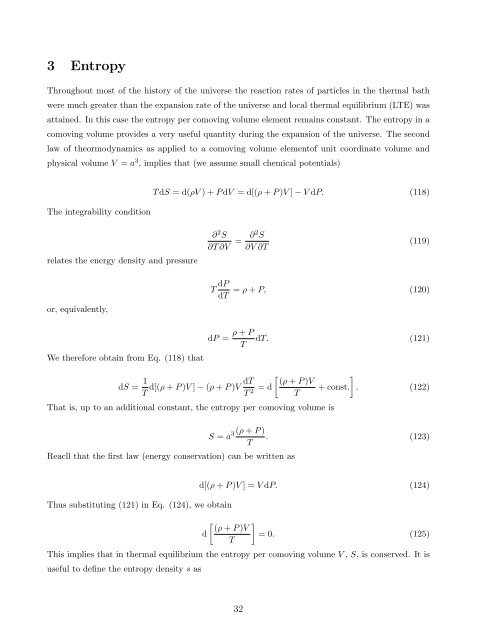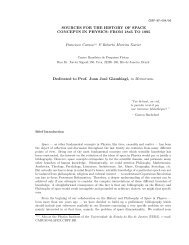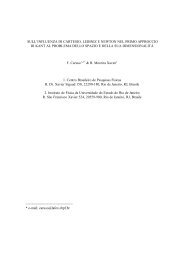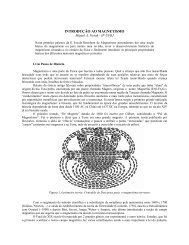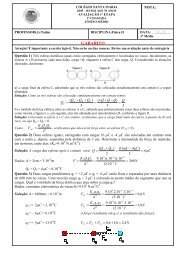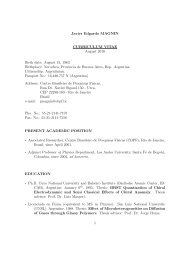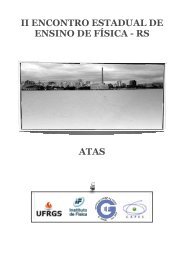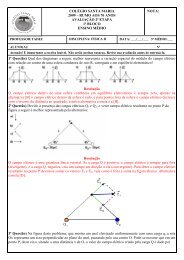Primordial non-Gaussianity in the cosmological perturbations - CBPF
Primordial non-Gaussianity in the cosmological perturbations - CBPF
Primordial non-Gaussianity in the cosmological perturbations - CBPF
Create successful ePaper yourself
Turn your PDF publications into a flip-book with our unique Google optimized e-Paper software.
3 Entropy<br />
Throughout most of <strong>the</strong> history of <strong>the</strong> universe <strong>the</strong> reaction rates of particles <strong>in</strong> <strong>the</strong> <strong>the</strong>rmal bath<br />
were much greater than <strong>the</strong> expansion rate of <strong>the</strong> universe and local <strong>the</strong>rmal equilibrium (LTE) was<br />
atta<strong>in</strong>ed. In this case <strong>the</strong> entropy per comov<strong>in</strong>g volume element rema<strong>in</strong>s constant. The entropy <strong>in</strong> a<br />
comov<strong>in</strong>g volume provides a very useful quantity dur<strong>in</strong>g <strong>the</strong> expansion of <strong>the</strong> universe. The second<br />
law of <strong>the</strong>ormodynamics as applied to a comov<strong>in</strong>g volume elementof unit coord<strong>in</strong>ate volume and<br />
physical volume V = a 3 , implies that (we assume small chemical potentials)<br />
The <strong>in</strong>tegrability condition<br />
relates <strong>the</strong> energy density and pressure<br />
or, equivalently,<br />
We <strong>the</strong>refore obta<strong>in</strong> from Eq. (118) that<br />
dS = 1<br />
T<br />
T dS = d(ρV ) + P dV = d[(ρ + P )V ] − V dP. (118)<br />
∂ 2 S<br />
∂T ∂V = ∂2 S<br />
∂V ∂T<br />
T dP<br />
dT<br />
dP =<br />
(119)<br />
= ρ + P, (120)<br />
ρ + P<br />
T<br />
<br />
dT (ρ + P )V<br />
d[(ρ + P )V ] − (ρ + P )V = d<br />
T 2 T<br />
That is, up to an additional constant, <strong>the</strong> entropy per comov<strong>in</strong>g volume is<br />
Reacll that <strong>the</strong> first law (energy conservation) can be written as<br />
Thus substitut<strong>in</strong>g (121) <strong>in</strong> Eq. (124), we obta<strong>in</strong><br />
dT. (121)<br />
<br />
+ const. . (122)<br />
3 (ρ + P )<br />
S = a . (123)<br />
T<br />
d[(ρ + P )V ] = V dP. (124)<br />
<br />
(ρ + P )V<br />
d<br />
= 0. (125)<br />
T<br />
This implies that <strong>in</strong> <strong>the</strong>rmal equilibrium <strong>the</strong> entropy per comov<strong>in</strong>g volume V , S, is conserved. It is<br />
useful to def<strong>in</strong>e <strong>the</strong> entropy density s as<br />
32


